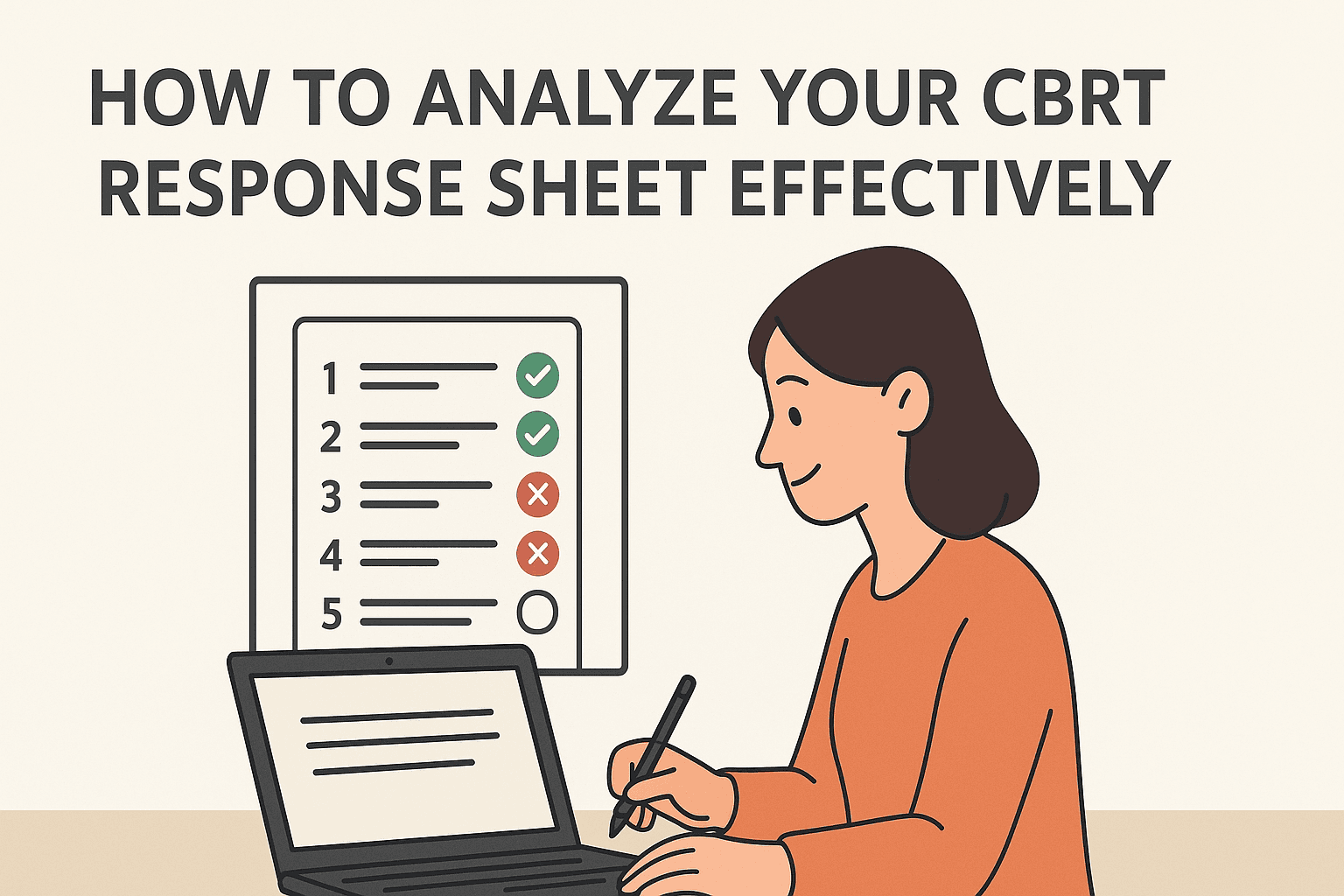How to Analyze Your CBRT Response Sheet Effectively
admin
@admin

How to Analyze Your CBRT Response Sheet Effectively: A Step-by-Step Guide
Analyzing your Computer-Based Recruitment Test (CBRT) response sheet is crucial for understanding your performance and strategizing for future exams. Here's a comprehensive guide to help you navigate this process effectively.
1. Understanding the CBRT Response Sheet
CBRT exams are conducted online, and after completion, candidates receive a response sheet detailing their answers. This sheet typically includes:
-
Question Number: Identifies each question.
-
Your Response: The option you selected.
-
Correct Answer: The officially recognized correct option.
-
Status: Indicates whether your answer was correct, incorrect, or unattempted.
Understanding this layout is the first step in effective analysis.
2. Accessing Your Response Sheet
Different examination boards have varying procedures for accessing response sheets. Here's a general approach:
-
Visit the Official Website: Go to the official website of the examination board.
-
Navigate to the Relevant Section: Look for sections labeled "Results," "Answer Keys," or "Response Sheets."
-
Login: Enter your credentials, such as registration number and date of birth.
-
Download: Access and download your response sheet for analysis.
For instance, the Gujarat Subordinate Service Selection Board (GSSSB) provides response sheets for CBRT exams on their official portal .
3. Analyzing Your Performance
Once you have your response sheet:
-
Tally Correct Answers: Count the number of questions you answered correctly.
-
Identify Incorrect Answers: Note the questions you got wrong and understand why.
-
Assess Unattempted Questions: Review the questions you left unanswered to determine if they were due to time constraints or uncertainty.
-
Calculate Your Score: Use the marking scheme provided by the examination board to compute your total score.
Some platforms, like Response Sheet Analyser, offer tools to automate this analysis, providing insights into accuracy, attempted questions, and more .
4. Identifying Patterns and Areas for Improvement
Analyzing your response sheet isn't just about calculating scores; it's about identifying patterns:
-
Subject-wise Performance: Determine which subjects or topics you performed well in and which need improvement.
-
Time Management: Assess if time constraints affected your performance, especially in unattempted questions.
-
Common Mistakes: Identify recurring errors, such as misreading questions or calculation mistakes.
-
Understanding these patterns can guide your preparation strategy for future exams.
5. Utilizing Analysis Tools
To streamline the analysis process, consider using specialized tools:
Response Sheet Analyser: This platform allows you to input your response sheet data and provides a detailed breakdown of your performance, including accuracy rates, attempted questions, and graphical representations of your results .
Such tools can save time and offer deeper insights into your exam performance.
6. Implementing Feedback into Preparation
Based on your analysis:
-
Focus on Weak Areas: Allocate more study time to subjects or topics where you underperformed.
-
Practice Time Management: Simulate exam conditions to improve your speed and efficiency.
-
Review Mistakes: Understand the reasons behind incorrect answers to avoid repeating them.
Regularly analyzing your performance and adjusting your preparation strategy accordingly can lead to significant improvements over time.
7. Staying Updated with Official Notifications
Examination boards often release provisional answer keys and allow candidates to raise objections. For example, GSSSB provides provisional answer keys for CBRT exams, and candidates can submit objections if they find discrepancies .
Staying informed about such updates ensures you can take timely action when necessary.
8. Maintaining a Positive Mindset
Analyzing your response sheet can sometimes be daunting, especially if the results aren't as expected. However:
-
View Mistakes as Learning Opportunities: Each error is a chance to improve.
-
Celebrate Small Wins: Acknowledge areas where you performed well.
-
Stay Motivated: Use the insights gained to fuel your preparation for future exams.
Remember, consistent effort and a positive attitude are key to success.
Conclusion
Analyzing your CBRT response sheet is an invaluable step in your exam preparation journey. By understanding your performance, identifying areas for improvement, and adjusting your study strategies accordingly, you can enhance your chances of success in future examinations.
Utilize available tools like Response Sheet Analyser to facilitate this process and gain deeper insights into your performance.
Stay proactive, stay informed, and keep striving for excellence.